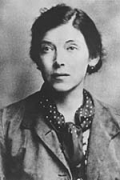 LOST Magazine is a monthly online publication that aims to “reclaim in writing lost people, places, and things.”
LOST Magazine is a monthly online publication that aims to “reclaim in writing lost people, places, and things.”
In the current issue, Emma Garman remembers Gamel Woolsey (1895-1968), the South Carolina poet and novelist who “was cursed with that shadowy defining quality of the greatest artists: the inability to coax life into satisfying her desires.”
Her ambitions for creative (to say nothing of romantic) fulfillment were continually, and almost comically, thwarted by fortune, and only through a bit of posthumous luck, and the efforts of friends who outlived her, do we know about the South Carolina-born writer at all. Neither of her novels was published in her lifetime, while only one volume of poetry, Middle Earth (1931), saw the light of day — a later one was rejected by T. S. Eliot at Faber & Faber, a blow that made Woolsey abandon all literary effort — and she was purposely written out of the biography of her one great love, the British author Llewelyn Powys, at the request of his widow.
The daughter of a cotton plantation owner and a society beauty half his age, Gamel (née Elizabeth) Woolsey spent an idyllic childhood in Aiken, South Carolina, a place she would always recall with nostalgia (“Where yesterdays are better than today” mourns the final line of her poem “Carolina Low Country”). Her father William Walton Woolsey was descended from a long line of influential Americans, including two Yale presidents; his sister was the bestselling author of What Katy Did, Susan Coolidge. When William Woolsey died in 1910, the family — teenage Elsa, as she was then known, her sister, brother and mother — moved to Charleston, where the bad luck that was to be Gamel’s perpetual companion soon began. At the age of 17 she fell madly in love with a boy who killed himself when he realized he was gay. Meanwhile, her mother became an alcoholic (traumatizing Gamel to the extent that she herself wouldn’t drink for many years), then at 20 she was diagnosed with tuberculosis and confined for a year to a sanatorium, where part of her lung was removed. She would often be troubled by recurrences of TB, especially at times of emotional strain, and the haunted, translucent appearance characteristic of “consumptives” enhanced her grave beauty, her gray eyes and dark hair.
When she was released from the sanatorium, Woolsey left South Carolina for New York. She was never to return, although many years later she revisited her Charleston adolescence in her second novel, Patterns in the Sand, a feminist exploration of a young woman’s coming of age in a sexist and confining culture, set at the outbreak of World War I. Written in England in the early 1940s, the novel alas remains unpublished, the manuscript held by the University of Texas at Austin…
Side note: Woolsey was related to the judge who ruled Ulysses not obscene.